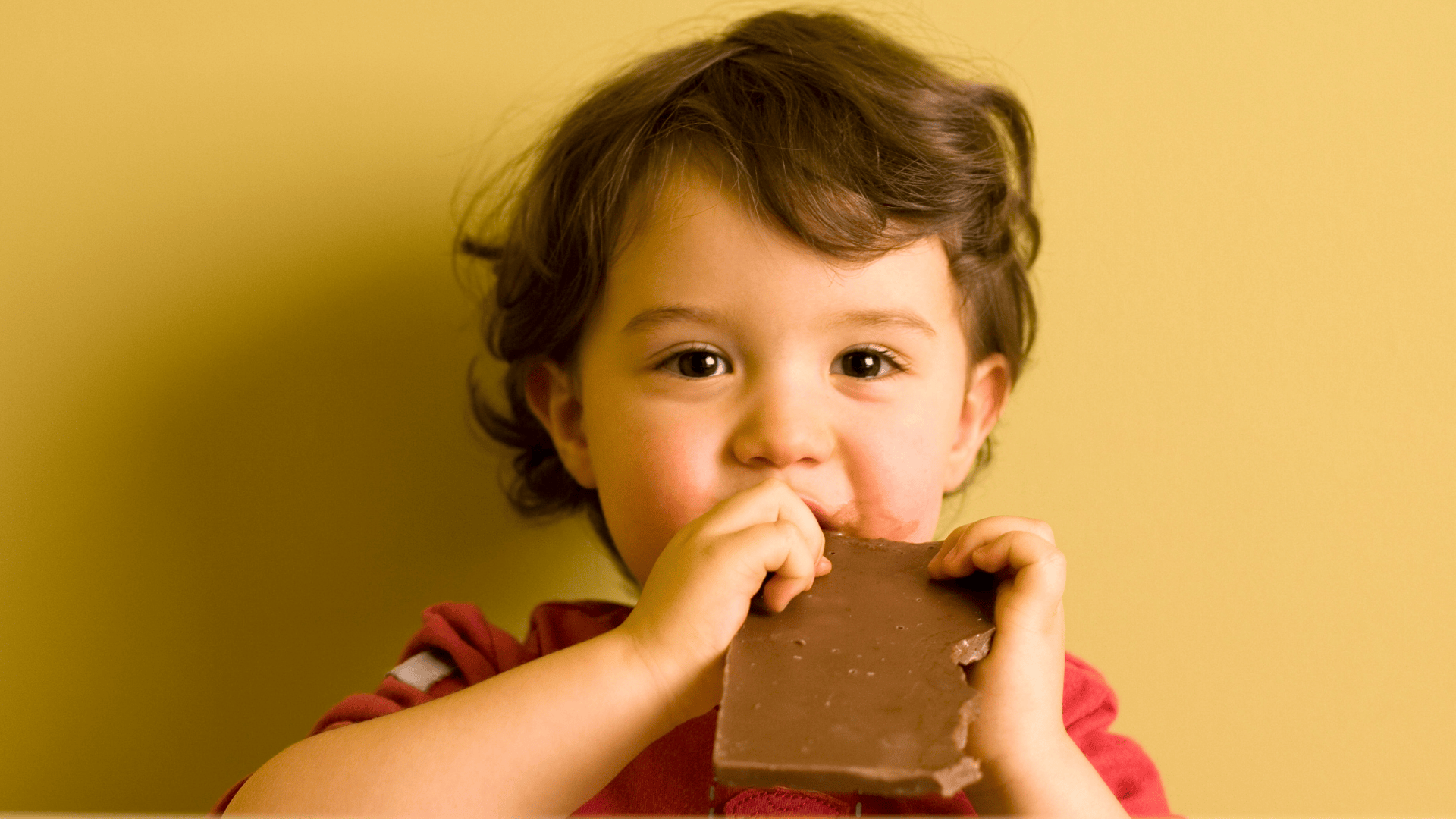Have you ever wondered when babies can have chocolate or if it’s safe to give them a tiny taste? Many parents ask this question, especially when their little one shows interest in sweets.
Chocolate may seem harmless, but it contains sugar, caffeine, and sometimes allergens that aren’t baby-friendly.
In this blog, I’ll walk you through what experts say about the right age for chocolate, the risks of offering it too early, and safer alternatives.
You’ll also find tips for handling accidental chocolate bites and how to set healthy sugar habits from the start.
When Can Babies Have Chocolate: Advice for Parents
Most pediatricians recommend waiting until after your baby’s first birthday before introducing chocolate.
Some suggest holding off until 18–24 months to avoid added sugar and caffeine. At this age, your baby’s digestive system is stronger, and they’re less likely to react badly.
Chocolate also often contains milk, soy, or nuts, which are common allergens. Delaying introduction gives you time to test these foods safely on their own before combining them with chocolate.
If you decide to offer it, keep the portion very small, use plain chocolate without extra fillings, and treat it as an occasional snack, not a regular part of their diet.
Why Waiting is Recommended

Health experts, including the American Academy of Pediatrics (AAP), advise against giving chocolate to babies under 2 years old. At this stage, their bodies are still developing, and chocolate brings more risks than benefits.
- Sugar: Increases the risk of cavities, unhealthy weight gain, and poor eating habits.
- Caffeine: Even small amounts can disrupt sleep, cause fussiness, and overstimulate babies.
- Allergens: Chocolate often includes milk, soy, or nuts; all common allergy triggers.
- Choking hazard: Hard or chunky pieces can be unsafe for babies learning to chew.
- Low nutritional value: Chocolate doesn’t add anything essential to your baby’s diet.
- Additives and preservatives: Many chocolates contain flavorings or chemicals not suitable for infants.
- Digestive sensitivity: Baby stomachs are delicate, and chocolate may cause gas, diarrhea, or discomfort.
Recommendations on Chocolate by Age
Babies don’t need chocolate early on, and timing makes a big difference. Here’s what is usually recommended at different ages:
| Age Range | Recommendation | Reason |
|---|---|---|
| Under 1 year | Avoid entirely | Babies’ digestive systems are immature, and chocolate adds sugar, caffeine, and allergens with no benefit. |
| 12–24 months | Tiny tastes are possible, but not ideal | Some experts allow very small amounts, but risks like sugar and sleep disruption remain. |
| After 2 years | Safer to introduce in moderation | By this age, digestion is stronger, and parents can manage portion sizes and monitor reactions. |
What If My Baby Accidentally Eats Chocolate?
Accidents happen, and sometimes babies get into foods they shouldn’t. Here’s what to expect if your little one eats chocolate and how to respond safely:
1. Mild Reactions
If your baby takes a small bite of chocolate, don’t panic. Most babies will only have mild effects such as a short period of fussiness, a small rash, or an upset tummy. These usually pass on their own.
Offering water and keeping your baby comfortable often helps.
2. Severe Symptoms
Some babies may react more strongly. Watch for signs like swelling around the lips or eyes, sudden vomiting, diarrhea, or breathing problems.
These could mean an allergic reaction or sensitivity to ingredients such as milk, soy, or nuts, often found in chocolate.
3. When to Call a Doctor
If symptoms are more than mild or your baby seems unusually sleepy, restless, or has trouble breathing, contact your doctor immediately.
Severe reactions like wheezing, swelling, or sudden drowsiness may need emergency care. It’s always safer to call your pediatrician if you’re unsure about your baby’s reaction.
Healthier Ways to Offer Chocolate (When the Time Comes)

Once your baby is old enough, chocolate can be introduced in small, careful ways. The key is to keep it safe, simple, and occasional so it feels like a treat without causing harm.
- Choose dark chocolate: Dark chocolate often has less sugar than milk chocolate. Look for options with a higher cocoa content and fewer added ingredients. This makes it a slightly better choice when offering a tiny taste.
- Avoid nut-filled or allergen-heavy chocolates: Many chocolates contain milk, soy, or nuts. These are common allergens, so stick with plain varieties first. Wait until you’ve tested these foods separately before introducing them in chocolate form.
- Give tiny, soft pieces only: Chocolate should melt easily in your baby’s mouth. Break it into very small pieces or let it soften slightly to reduce the risk of choking. Avoid hard or chunky chocolate candies.
- Offer occasionally, not daily: Chocolate should never replace regular snacks or meals. Think of it as a rare treat for special moments instead of something your baby expects every day.
- Check ingredient labels carefully: Some chocolates include caffeine, artificial flavors, or preservatives. Choose the simplest option possible to avoid unnecessary additives.
- Pair with healthier foods: You can offer a small chocolate dip with fruit like banana slices or strawberries once your child is older. This makes the treat more nutritious.
Healthy Alternatives to Chocolate
If you want to offer sweet flavors before your baby is ready for chocolate, there are safer options. These give them a taste of sweetness without the risks.
| Age | Alternative | Why It’s Better |
|---|---|---|
| 6–12 months | Mashed fruits, plain yogurt | Naturally sweet, no caffeine or added sugar |
| 12–24 months | Fruit purée popsicles | Cooling, safe, and gentle on digestion |
| 2+ years | Cocoa smoothies or homemade treats | Softer texture, controlled sugar levels |
Setting Healthy Sugar Habits Early
Building healthy sugar habits starts in the first years of life. Babies don’t need added sugars, and keeping sugar low early helps protect their growth and health.
Sweet treats should be kept for special occasions, not everyday snacks.
By offering whole foods like fruits, vegetables, grains, and proteins first, you encourage your baby to enjoy natural flavors before introducing desserts.
This approach also helps prevent picky eating and reduces the chance of your child becoming too dependent on sugar.
Avoiding sugary drinks such as juice or soda makes a big difference as well. When parents model balanced choices, babies are more likely to follow along.
Conclusion
Deciding when babies can have chocolate is a question many parents face, and now you know what experts recommend.
Chocolate under age 2 brings more risks than benefits from sugar and caffeine, to allergens and choking hazards.
Once your little one is older, small, occasional tastes can be safer if you choose simple options. I remember how careful I was when offering sweets for the first time, and keeping balance made it easier.
By focusing on natural alternatives early and saving chocolate for special moments, you’ll set up healthier eating habits for your child.










